If you’re thinking about keeping chickens for the first time or you’re looking to expand your flock then keeping ex-battery hens can be one of the most rewarding things you can do to enable chickens who’ve had a tough time to live a happy life in a forever home.
Ex-battery hen charities work tirelessly to find new happy homes for hens and with more collection points popping up, finding ex-battery hens locally is becoming much easier.
We found the experience so rewarding that any new additions to our flock are either ex-battery or re-homed chickens which people can no longer keep.
In this article, I want to show you everything you need to know about keeping and caring for ex-battery hens from day one, along with information about what you can expect from your girls as the weeks progress in their new life.
What is an ex-battery hen?
Firstly I just want to explain what an ex-battery or farmed hen is and the kind of conditions they will have lived in throughout their lives so far.
By understanding all they know so far it makes it easier to understand their behaviour and appearance when they’re sent for rehoming.
Most rehoming charities don’t disclose where the hens come from, but in most intensive farm situations hens are kept indoors in confined cages or in an open but cramped space with thousands of other hens.
Hens are fed and exposed to unnatural lighting to optimize egg production until they are 18 months old and deemed as no longer productive.
Without the help of the rehoming charities, it’s likely the hens would be slaughtered (usually for pet food) because the cost of feeding outweighs the profits.
Because hens become bored and frustrated living in cramped conditions this can ofter lead to pecking and in many cases, caged hens will have bald patches and sores on their skin.
Being kept in this way means the hens will not have done any of the natural things which chickens love to do including scratching for food, laying eggs in a nest and roosting at night.
How can you get ex-battery hens
There are a number of rehoming charities which find good homes for commercial hens, some operate nationally with local hubs and some are more local. The best way to find a charity near you is by searching online or by joining rehoming groups on Facebook.
Being located in Wales in the UK, we use Fresh Start for Hens, you can register and see the latest rehoming dates here.
In general, the charity will liaise with the farm and arrange a bulk pick up of hens a specific date.
In the meantime they’ll vet potential new owners and if they meet the requirements a time and date for collection from a local hub will be given.
You might need to wait for a month or so for a collection date in your area, but this is a good chance to get prepared for your new hens. Ex-battery hens are worth the wait, not just for you but for them too.
The charity will want to find out more about you and your outside space before they agree to let you have some hens. They will probably also want to see pictures of where the hens will live and what outside space you can provide.
Preparing for ex-battery hens
If you’re new to keeping chickens then you’ll need to get kitted out with some equipment before your hens arrive.
You can spend as much or as little on hen equipment as you can afford, there are many ways to improvise without spending much money, such as getting a second-hand coop or using a shed as a shelter.
As long as the area is secure from predators, easy to clean, mite free and the hens have a place to roost and nest, they will be happy.
The main items of equipment you will need for your commercial hens are:
- A secure coop which includes roosting bars, nesting boxes and a pop hole so the hens can get in and out.
- A run around the coop which is secure from predators.
- Feeders and drinkers – although you can improvise with large bowls etc.
- Straw (not hay) for the nest boxes.
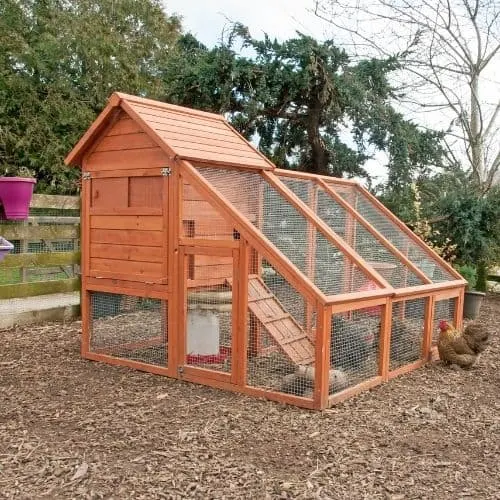
You will also need to consider flooring for the coop and run particularly in the winter months – you might find the following post helpful on this topic:
Do chickens need grass in their run
The key to buying a coop and run is to make sure there is enough space per hen, both inside the coop and in the run. The seller will normally state the recommended amount of hens for a specific coop, but if in doubt, ask before you buy.
Providing some free-range space outside the run is the best gift you can give to a commercial hen who has probably never been outdoors before.
Feeding ex-battery hens
As well as being prepared with physical equipment you’ll also need to have the right food ready for your hens for the day they arrive.
Commercial hens are usually fed with ‘layers mash’ which is easy to eat and digest feed which is good for egg production and quality.
You can buy layers mash, but generally pellets are more readily available.
Because they’re used to eating the mash type feed, they may not recognize pellets as food at first.
Sadly some commercial hens get their beaks clipped to prevent them from pecking each other, in this case feeding mash on an ongoing basis is probably best.
If you can’t buy layers mash you can create it by covering pellets with some water. You’ll find that your hens will quickly move onto pellets, especially if you already have other birds who eat them.
Below is an image of some of our ex-battery hens enjoying their meal of layers pellets:
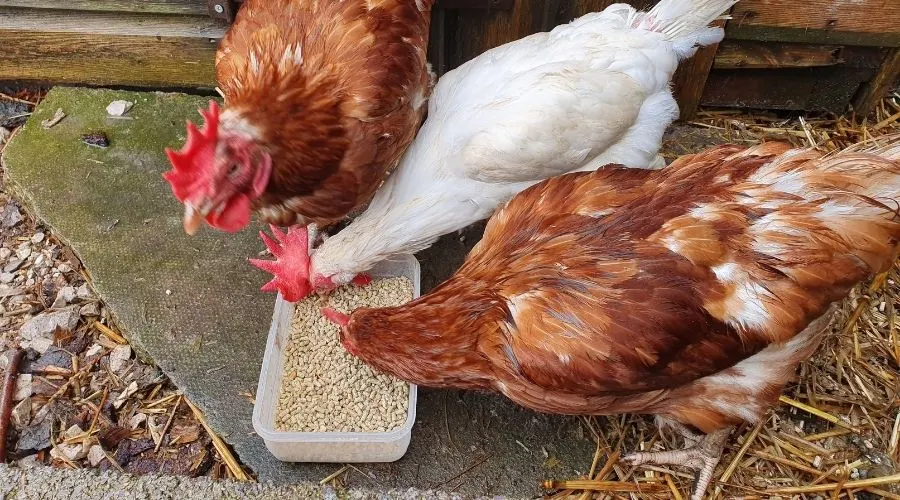
Because the hens will probably still be laying, a layers feed which contains more calcium is best for producing a strong eggshell. Although growers feed along with a supplement of oyster shell for calcium also works well.
Hens also enjoy a handful of corn feed later in the day, along with some veggie treats here and there (see the link at the bottom of this page on what chickens should eat).
If the hens are able to free-range, they’ll naturally eat bugs, worms, slugs and greens which they find as they graze. Natural foods are packed full of nutrients which are perfect for chickens who have lived a tough life.
It’s also important that chickens have access to grit which helps them digest their food, if they’re free-range they should find this naturally, for more information on grit and feeding you might find the following posts helpful:
Do chickens need grit and oyster shells and whats the difference
What should chickens eat by age
Collecting ex-battery hens
On collection day you will be given instructions and possibly a time slot because it’s likely they will have many pick-ups throughout the day.
The charity members complete a health check on each chicken and they will have had some time to rest after their journey from the farm to the collection point.
In some cases, the hens may have travelled a long distance from the farm to the rehoming centre.
Naturally, the hens will be stressed due to the complete change from what they’re used to, so a smooth and calm delivery to their new home is key.
The best way to transport the hens is in a large cardboard box with plenty of holes cut into the sides and top for ventilation. Lining the box with straw will make the box more comfortable for the hens during the journey.
Ex-battery hen appearance
Be prepared for the appearance of your new hens, in most cases they will have bald patches, sores and their feathers will be very thinned out due to moulting. This should improve given time (for more information see the section on feathers below).
They will also have pale faces and combs due to the fact they’ve never seen sunlight. Their faces, combs and wattles (the dangly bits under the chin) will become redder once they’re exposed to daylight.
Introducing ex-battery hens to their new home
If you already have chickens
If you already keep hens it’s best to keep them separated when you first introduce the commercial hens to their new home.
This is especially important if the existing hens have a pecking order because there’s potential that the top hen/s will attack any new chicken/s placed in the coop.
When we got our first batch of ex-battery hens our existing flock were very young (around 20 weeks), so they happily mixed in with no issues. In fact, one of the rescue hens quickly took control of the new flock and became top of the pecking order within a matter of days.
The best way to introduce hens is by keeping them separated while allowing them to see each other. The final introduction works best at a dusk time when they’re about to go into roost and are generally more relaxed.
Rubbing vaseline onto the chicken combs and wattles can help to prevent cuts if any pecking does happen.
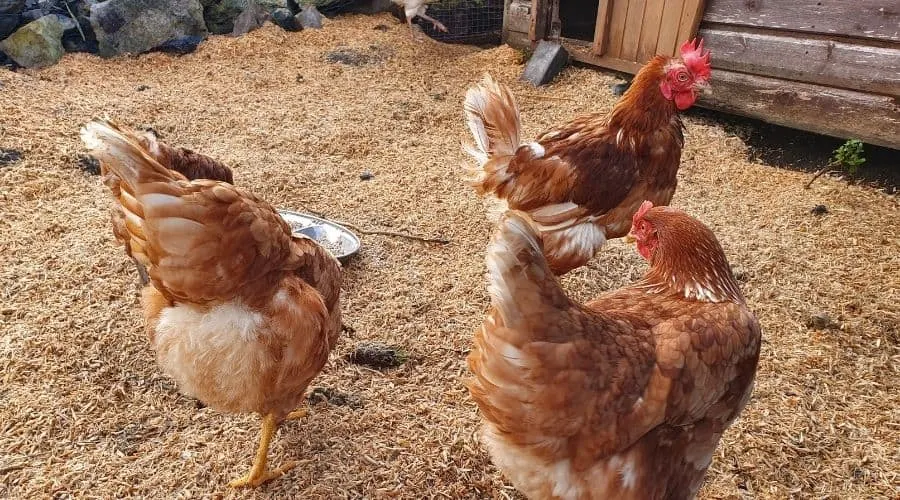
Releasing the hens into their new run/coop
Once you’ve collected your new hens, place the box into the enclosed run and allow the hens to step out into their new surroundings. Make sure the pop hole to the coop is open because ex-battery hens are used to the security of being indoors.
The hens might be thirsty and maybe even hungry after their journey so make sure they have access to food and water in the run.
The hens may be very frightened when they first arrive, which is only natural given the fact they’ve probably never even been outside before. Don’t worry, because they will get more confident in time.
What to expect from your ex-battery hens in the first few days
In the first few days of your ex-battery hen’s new lives, they will be steadily be getting used to their new surroundings and routine.
It’s normal for the hens to hide away in the coop while they get used to things, don’t worry if this is the case, they’ll soon find their confidence and will start to enjoy being a real hen.
Due to a lack of daylight and space in the commercial environment, the hens may have weak bones and muscle wastage, because of this they may be sluggish and prone to sitting more in the day. This is completely normal and will improve in time.
When it comes to roosting they probably won’t roost on a bar because they’re not used to it, in which case they’ll snuggle up in a nest box instead.
Some chicken keepers prefer their hens to roost on a bar, but our view is to leave it up to whatever the chicken finds most warm and comfortable.
This does lead to more mess in the nest, but the top layer can easily be lifted out each morning.
Some of our rescue hens now prefer to roost on bars, but some still find the nests more comfortable.
If you’re intending to let your hens free-range, it will be fine to let them out of the run after two or three days of getting used to the coop area.
We find that the best way to do this is by letting them out later in the day on day two so they can have a quick look around before going back in to roost.
They don’t tend to move far from the safety of the coop anyway so you should have no problems getting them to go back in at the end of the day.
Below is an image of our commercial hens being allowed to free-range for the first time, but staying close to the entrance of their run.
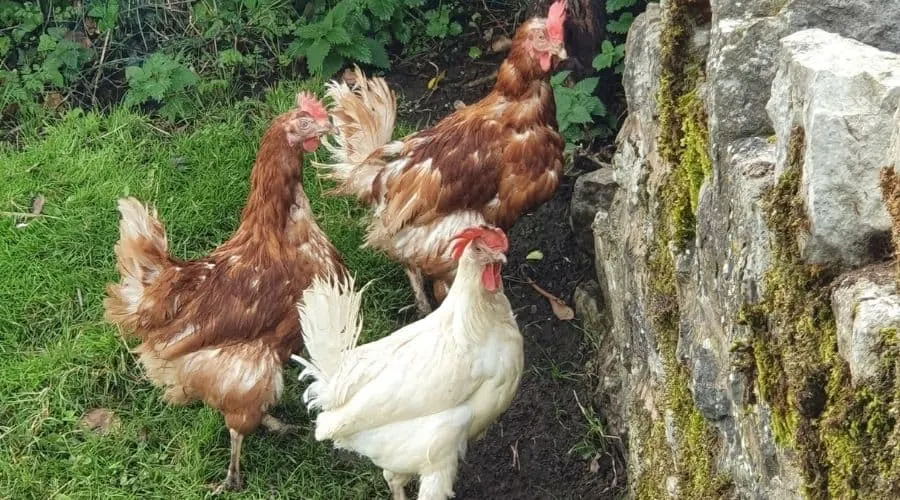
If a hen seems to be particularly flighty then you might want to leave them in the run to get used to things for an extra day.
Ex-battery hen egg production
One of the main questions asked by potential ex-battery hen owners is, will they continue to lay once they’re rehomed?
In most cases ex-battery hens will continue to lay for some time until they retire for good, however, in some more rare cases, they may never lay another egg.
people tend to re-home ex-battery hens with a view to giving them a better chance of life and any egg they lay is just a bonus.
We’ve been very lucky in that our hens have carried on laying almost daily, although it is normal for them to stop for a few days after they’re introduced to their new home.
Battery hens are also used to laying where they stand and afterwards their eggs roll away for packing. For this reason, you may see eggs on the ground while they get used to their nests.
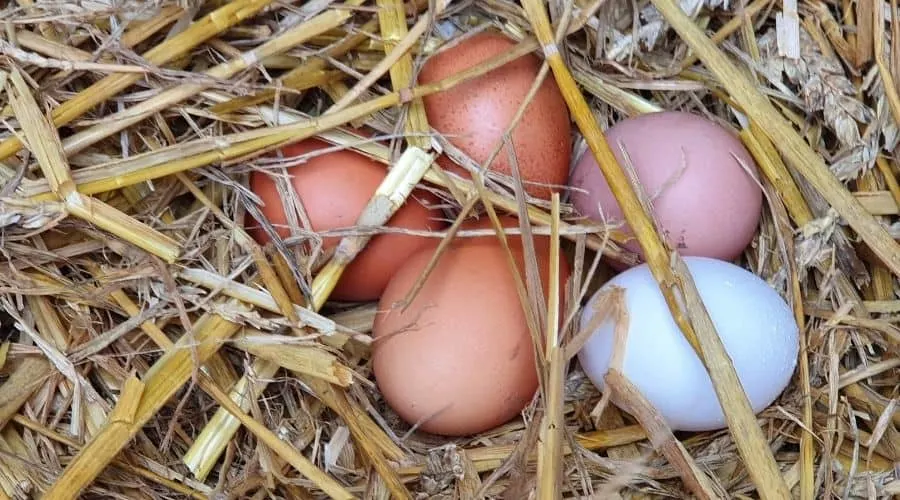
To avoid breakages it’s best to collect the eggs as soon as you can because broken eggs can lead to egg eating. For more information on eggs, you might find it helpful to read the two following posts:
Chickens eating eggs – why they do it and how to stop it
Ex-battery hen breeds
The most common breed of battery hen is a hybrid, which is usually ginger in colour.
Hybrid chickens are generally used for egg production in the UK because they’re bred for their high egg yield along with a more placid nature. Hybrid hens lay a large egg in varying shades of brown.
Another popular breed for producing eggs (especially in the US) is the White Leghorn, who are also known for a high egg yield and their large white eggs. Leghorns tend to be a bit more flighty and timid than a hybrid, but they’re a lovely bird and ours lays every day without fail.
You might find that you get offered a mix of breeds when you collect your birds, this is a great way to get mixed egg colours and to get to know different breeds.
The health of an ex-battery hen
When you collect your ex-battery hens they should have already had a health check before they’re signed off to go for rehoming.
Because of the extreme conditions, the hens have been subjected to on the farm they are generally not as healthy looking as a chicken which has lead a free-range and happy life.
It’s also likely that they’ll be going through a moult which is normal for chickens who are around 18 months old.
During moulting, chickens can become quiet and egg production may drop or stop altogether for a period of time. It’s for this reason that chicken farms don’t want to keep hens once they reach 18 months.
In most cases, the hens will go onto thrive especially once they start getting some good nutritious food inside them along with some natural daylight.
You can buy vitamin supplements for hens and apple cider vinegar in the water is also recommended for hens who are in recovery.
If you feel that your chicken is sick or they’re hunched up and look like they’re in pain see medical advice from a vet.
Chickens need worming medication once every six months along with mite and louse prevention which is usually sold in powder form which can be dusted directly onto the hen or added to their dust bath.
Red mites can become an issue for chicken keepers and once an infestation sets in they can be very difficult to remove from the coop despite best efforts. Plastic coops which can be easily cleaned are a good way to reduce a possible red mite infestation.
Ex-battery hen feather growth & moulting
The sight of a hen with half it’s feathers missing can be worrying, but unfortunately, this is standard for most ex-battery hens. Not just because they’re going through the moulting process but because of the pecking they experience when they’re kept together in a confined space.
You may also notice red patches on the chickens skin which can look sore but shouldn’t bother the chicken too much.
This will get better in time and after a month or two you should start to see some regrowth and fluffy new feathers around the bottom area.
It’s good to be aware that in particularly bad cases some bald patches may take many months to regrow and may never fully grow back.
Key Takeaways
- Understanding Ex-Battery Hens: Ex-battery hens have experienced confined and suboptimal living conditions, impacting their physical and behavioral health. They often have bald patches, sores, and may exhibit unique behaviors due to their previous environments.
- Adoption and Preparation: Adopting these hens involves liaising with charities and preparing a suitable living environment. Ensuring a secure coop, adequate feed, and understanding their potential initial fear and hesitancy are crucial for a smooth transition to their new home.
- Feeding and Health Care: Providing appropriate nutrition, including layers mash or pellets and access to clean water, is vital. Additionally, considering their health, which may be compromised due to previous living conditions, and providing supplements and care, will support their recovery and ongoing well-being.
Ex-battery hen FAQ’s
When hens are re-homed via an ex-battery rehoming charity there is no charge as such, but the charity will usually ask for a minimum donation of £2.50 per hen. It’s then up to the recipient of the hens as to how much they donate. These donations help the charity to continue their valuable work.
A chicken will usually live for up to five or even seven years, sadly the life expectancy for ex-battery hens is generally lower at around three to fours years. This is due to the poor quality of life during their time on a commercial farm.
This article was first published on October 26, 2020 by Pentagon-Pets.
Ex-battery hens are vaccinated to prevent the spread of disease during their time on the farm. Re-homing charities will confirm that your birds have been vaccinated, but if you are unsure you can check prior to collection.
More resources which you may find helpful
I hope this page has helped you to find out everything you need to know about caring for ex-battery hens.
Helping hens who’ve had such a tough time to live out their lives being happy and healthy is so rewarding and the hens will love you for it too!
If you’re new to chicken keeping you might find the following posts helpful for your journey:
7 ways to get chickens back into the coop to roost at night
Pentagon Pet is the owner of this article that was first published on October 26, 2020.
What should chickens eat – a complete guide
Will chickens run away if you let them loose to free-range?
Can you keep chickens in the coop or run all day?
Do chickens need a run around their coop?
Our recommended coop
Chicken coop for different flock sizes and different weather.
This article and its contents are owned by Pentagon Pets and was first published on October 26, 2020.

